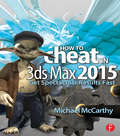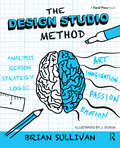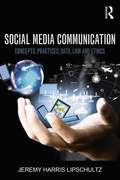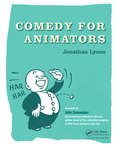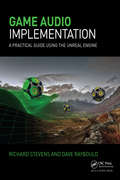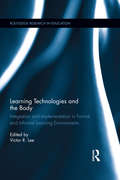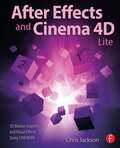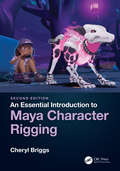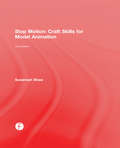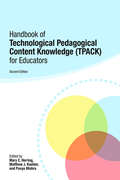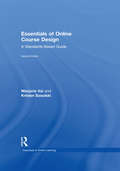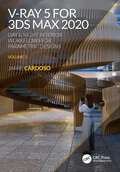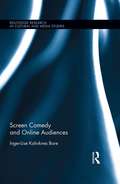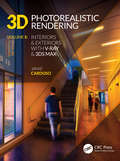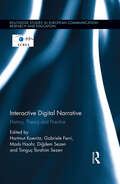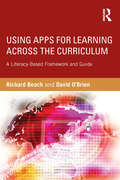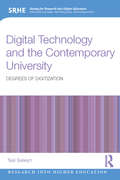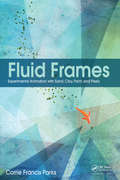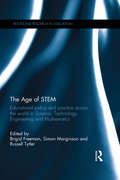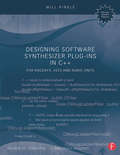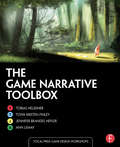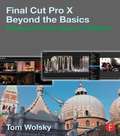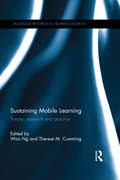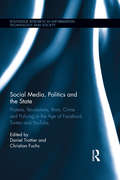- Table View
- List View
How to Cheat in 3ds Max 2015: Get Spectacular Results Fast (How To Cheat)
by Michael McCarthyWhy take months to learn every button in 3ds Max when you can create great visuals with just a few key tools? Utilize the tool of choice, 3ds Max 2015, for generating realistic environments, seamless CG effects, and jaw dropping games in a matter of hours. You can use the memory-hogging methods that choke your display and take forever to render, or you can get it done quickly and efficiently. <P><P> Michael McCarthy offers a goldmine of artistic inspiration, timesaving tips & tricks, and step-by-step walkthroughs—you’ll wonder how you every got by without it! This new edition has been completely revamped for 3ds Max 2015. Start animating today with detailed tutorials, source files, bitmaps, and video demonstrations—all featured on the companion website.
The Design Studio Method: Creative Problem Solving with UX Sketching
by Brian K SullivanThe struggle with balancing creative products that are innovative, technically feasible, and financially sound is one designers and web professionals go through every day. The Design Studio Method is a creative problem solving process that allows you to quickly generate ideas, evaluate them, and reach consensus, achieving that balancing act. Brian Sullivan’s The Design Studio Method gives answers that you have been looking for, showing you how to be innovative and efficient without sacrificing quality and collaboration. This book simplifies the complicated method, explaining each step, each participant’s involvement, and how to adapt the method to your needs. The Design Studio Method provides step-by-step procedures to ensure your success. From illumination, to generation, to presentation, all the way to iteration, this book provides the road map you’ll need to start generating innovate products. Shows you how to involve all members of the creative process—from clients to directors—so that everyone participates, critiques, and innovates. Features real-world examples of Design Studio projects that highlight the successes of this method and ways to adapt it to your needs. Includes a website that showcases videos covering each step of the method and other procedures that crop up along the way.
Social Media Communication: Concepts, Practices, Data, Law and Ethics
by Jeremy Harris LipschultzIn Social Media Communication: Concepts, Practices, Data, Law and Ethics, Jeremy Harris Lipschultz presents a wide-scale, interdisciplinary analysis and guide to social media. Examining platforms such as Twitter, Facebook, LinkedIn, Pinterest, Youtube and Vine, the book explores and analyzes journalism, broadcasting, public relations, advertising and marketing. Lipschultz focuses on key concepts, best practices, data analyses, law and ethics--all promoting the critical thinking professionals and students need to use new networking tools effectively and to navigate social and mobile media spaces. Featuring contemporary case studies, essays from some of the industry's leading social media innovators, and a comprehensive glossary, this practical, multipurpose textbook gives readers the resources they'll need to both evaluate and utilize current and future forms of social media. For more information about the book, supplementary updates and teaching materials, follow Social Media Communication online at: Facebook: https://www.facebook.com/SocialMediaCommunication Twitter: @JeremyHL #smc2015 SlideShare: http://www.slideshare.net/jeremylipschultz
Comedy for Animators
by Jonathan LyonsWhile comedy writers are responsible for creating clever scripts, comedic animators have a much more complicated problem to solve: What makes a physical character funny? Comedy for Animators breaks down the answer by exploring the techniques of those who have used their bodies to make others laugh. Drawing from traditions such as commedia dell'arte, pantomime, Vaudeville, the circus, and silent and modern film, animators will learn not only to create funny characters, but also how to execute gags, create a comic climate, and use environment as a character. Whether you're creating a comic villain or a bumbling sidekick, this is the one and only guide you need to get your audience laughing! Explanation of comedic archetypes and devices will both inspire and inform your creative choices Exploration of various modes of storytelling allows you to give the right context for your story and characters Tips for creating worlds, scenarios, and casts for your characters to flourish in Companion website includes example videos and further resources to expand your skillset--check it out at www.comedyforanimators.com! Jonathan Lyons delivers simple, fun, illustrated lessons that teach readers to apply the principles of history's greatest physical comedians to their animated characters. This isn't stand-up comedy--it's the falling down and jumping around sort!
Game Audio Implementation: A Practical Guide Using the Unreal Engine
by Richard Stevens Dave RaybouldGame Audio Implementation offers a unique practical approach to learning all about game audio. If you've always wanted to hear your sound or music in a real game then this is the book for you. Each chapter is accompanied by its own game level where you can see the techniques and theories in action before working through over 70 exercises to develop your own demo level. Taking you all the way from first principles to complex interactive systems in the industry standard Unreal Engine© you’ll gain the skills to implement your sound and music along with a deep transferable knowledge of the principles you can apply across a range of other game development tools. <P><P> The accompanying website (www.gameaudioimplementation.com) includes: <P><P> <P><P>12 downloadable demonstration games <P><P>A unique exercise level for you to develop for your portfolio <P><P>An up-to-date online bibliography with further reading for each chapter <P><P>A free sound library with hundreds of game SFX
Learning Technologies and the Body: Integration and Implementation In Formal and Informal Learning Environments (Routledge Research in Education #135)
by Victor R. LeeThis volume explores how technology-supported learning environments can incorporate physical activity and interactive experiences in formal education. It presents cutting-edge research and design work on a new generation of "body-centric" technologies such as wearable body sensors, GPS tracking devices, interactive display surfaces, video game controller devices, and humanlike avatars. Contributors discuss how and why each of these technologies can be used in service of learning within K-12 classrooms and at home, in museums and online. Citing examples of empirical evidence and specific implementation, this timely and critical volume examines how body responsive technologies are being used within the educational community to advance the next generation of educational technology.
After Effects and Cinema 4D Lite: 3D Motion Graphics and Visual Effects Using CINEWARE
by Chris JacksonOne of the most exciting new features in After Effects is the integration of Cinema 4D using the CINEWARE plug-in and a free version of Cinema 4D Lite. Both provide a wide assortment of new 3D tools and options that are difficult or nearly impossible to achieve in After Effects alone. This book clearly demonstrates how the new 3D workflow bridges the two applications together to raise the design bar for motion graphics and broadcast design. Hands-on exercises teach you essential production skills including: Modeling in CINEMA 4D Lite Importing 3D models in After Effects Tracking 3D motion in After Effects Compositing with CINEWARE Using MoGraph features in CINEMA 4D Rendering and optimization techniques Additional online materials include project files and videos showcasing the techniques covered in the book. To access these materials, please see the 'eResources' tab.
An Essential Introduction to Maya Character Rigging
by Cheryl BriggsWhile some rigging books focus too much on the theory of rigging and provide little instruction, others do the exact opposite and offer no reasoning behind the button-pushing. An Essential Introduction to Maya Character Rigging, 2nd Edition, however, offers a perfect balance. Cheryl Briggs’ text is built for the classroom, with step-by-step tutorials that guide the reader through the rigging process. With vibrant screenshots and a plethora of helpful tips, this book provides a strong foundation in character rigging for anyone who wants to pursue 3D animation or more advanced rigging topics. Features Provides readers with fundamental techniques to give them a firm grasp on Maya character rigging. Thorough step-by-step tutorials, which provides instruction on how to create biped, quadruped, and prop rigs. Continuous updates and further support can be located at www.cherylcreates.com Cheryl Briggs (formerly Cabrera) is an award-winning animated short film director. She has advised and guided aspiring animators, game artists, and visual effects artists for 20 years. Since 2009, Cheryl has taught all aspects of production in the Character Animation specialization in the School of Visual Arts and Design at the University of Central Florida. She also taught as Professor of Animation at the Savannah College of Art and Design from 2001 to 2009. Cheryl is currently on the Board of Directors for the Animation Hall of Fame. She also is a member of the Special Interest Group on Computer Graphics and Interactive Techniques (SIGGRAPH), the International Animated Film Society (ASIFA-Hollywood), Women in Animation, Women in Film and Television, and the Society for Animation Studies. Cheryl is also an Autodesk Certified Professional and an Autodesk Certified Instructor in Maya. She is the author of An Essential Introduction to Maya Character Rigging (Focal Press, 2008), Reel Success: Creating Demo Reels and Animation Portfolios (Focal Press, 2013), and Animating Short Stories: Narrative Techniques and Visual Design (Bloomsbury Academic, 2019). Cheryl holds a B.A. and M.Ed. in Education and an M.F.A. in Computer Art with a specialization in 3D Animation. She is a digital artist and animator that blends the lines between digital imagery and the traditional painting medium. She has participated is numerous group and solo exhibitions in the United States and her work is featured in several private collections. Her award-winning students have been featured in animation festivals worldwide, and many have gone on to work within the entertainment industry.
Stop Motion: Craft Skills For Model Animation
by Susannah ShawStop motion animation is a challenging and time-consuming skill that requires patience, adaptability, and a close eye to detail. Stop Motion: Craft Skills for Model Animation, 3rd Edition is the essential guide to help stop motion animators overcome these challenges of this highly-skilled craft. Author Susannah Shaw provides a step-by-step guide to creating successful stop motioin films. Starting with some basic exercises, the reader will learn about developing a story, making models, creating sets and props, the mechanics of movements, filming postproduction, and how to set about finding that first elusive job in a modern studio. Key Features Interviews with current stars, step-by-step examples, coverage of Rapid Prototyping and Dragonframe Software
Handbook of Technological Pedagogical Content Knowledge (TPACK) for Educators
by Mary C. Herring, Matthew J. Koehler and Punya MishraThe 2nd edition of the Handbook of Technological Pedagogical Content Knowledge (TPACK) for Educators addresses the concept and implementation of technological pedagogical content knowledge—the knowledge and skills that teachers need in order to integrate technology meaningfully into instruction in specific content areas. Driven by the growing influence of TPACK on research and practice in both K-12 and higher education, the 2nd edition updates current thinking about theory, research, and practice. Offering a series of chapters by scholars in different content areas who apply the technological pedagogical content knowledge framework to their individual content areas, the volume is structured around three themes: Current thoughts on TPACK Theory Research on Technological Pedagogical Content Knowledge in Specific Subject Areas Integrating Technological Pedagogical Content Knowledge into Teacher Education and Professional Development The Handbook of Technological Pedagogical Content Knowledge (TPACK) for Educators is simultaneously a mandate and a manifesto on the engagement of technology in classrooms.
Essentials of Online Course Design: A Standards-Based Guide (Essentials of Online Learning)
by Marjorie Vai Kristen SosulskiIn spite of the proliferation of online learning, creating online courses can still evoke a good deal of frustration, negativity, and wariness in those who need to create them. The second edition of Essentials of Online Course Design takes a fresh, thoughtfully designed, step-by-step approach to online course development. At its core is a set of standards that are based on best practices in the field of online learning and teaching. Pedagogical, organizational, and visual design principles are presented and modeled throughout the book, and users will quickly learn from the guide’s hands-on approach. The course design process begins with the elements of a classroom syllabus which, after a series of guided steps, easily evolve into an online course outline. The guide’s key features include: a practical approach informed by theory clean interior design that offers straightforward guidance from page one clear and jargon-free language examples, screenshots, and illustrations to clarify and support the text a checklist of online course design standards that readers can use to self-evaluate. a Companion Website with examples, adaptable templates, interactive learning features, and online resources: http://essentialsofonlinecoursedesign.com Essentials of Online Course Design serves as a best practice model for designing online courses. After reading this book, readers will find that preparing for online teaching is a satisfying and engaging experience. The core issue is simply good design: pedagogical, organizational, and visual. For more of Marjorie Vai in her own words, listen to this 2011 interview from the On Teaching Online podcast: http://onteachingonline.com/oto-16-essentials-of-online-course-design-with-marjorie-vai/
Photography Careers: Finding Your True Path
by Mark JenkinsonPhotography Careers offers students an indispensable guide to beginning their professional journeys as photographers. This book presents the variety of career options available to those entering the competitive and comprehensive world of photography. With the insight and advice from industry mavens and the author himself, Photography Careers will help you change the way you evaluate your strengths as an artist and find your place in the photography community. Features include: Interviews with successful young professional photographer in a wide range of photographic specialties, from fashion photography to cinematography, and other industry related fields such as retouching, fine art sales, and photo editing Tips for how to find unique approaches in a saturated market Best practices for student looking at graduate programs, a budding career, and as a personal business
V-Ray 5 for 3ds Max: Day & Night Interior Workflows for Parametric Designs, Volume 2 (3D Photorealistic Rendering)
by Jamie CardosoRevitalize your architectural visualizations by bringing new levels of realism to your day and night interior scenes. This book features full-color, step-by-step tutorials to develop a firm understanding of the processes and techniques involved in creating jaw-dropping 3d visualizations for top marketing agencies. This second volume includes day and night lighting of an atrium scene using seasoned tools and techniques to deploy V-Ray 5 and 3ds Max 2020. It has never been quicker and easier to create the industry’s top-of-the-range 3d marketing visuals. The book starts with an overview of the best techniques to approach clients via emails, calls, meetings, and social media. There are also key insights into the best practices of handling projects, pricing, contracts, invoices, pre-production, production, post-production, etc. The subsequent step takes users through the installation of V-Ray 5 and the process of accessing the V-Ray Material browser dialog. Throughout the book, users are taken through VRayMtl functions such as Diffuse, Roughness, Reflect, Glossiness, Metalness, Refract, IOR, Abbe number, Fog color, Translucency, BRDF, Coat, Sheen and Bump. Users will also learn how to use procedural maps such as VRayBitmap, VRayTriplanarTex, Bricks, Metals, Carpaint, VRayDisplacementMod, VRayUVWRandomizer, VRayMultiSubTex, VRayPointCloudColor, VRayDirt, VRayAerialPersepective, VRayLightMtl, VRayMtlWrapper, VRayOverrideMtl, VRay2SidedMtl, VRayBlendMtl and VRayEdgesTex. Users will have a rare insight into all functionalities of a V-Ray camera, VRayLight objects, Render settings, Frame buffer, Global switches, IPR options, Bucket and Progressive image samplers, Image filters, Global DMC, Color mapping, Brute force GI, Light cache, Color management, Distributed rendering, Render elements, V-Ray image file format, VFB History settings, VFB Lens Effects, LightMix, Film tonemap, Hue/Saturation, Lookup Table and much more. Finally, users will embark on the amazing journey of utilizing the previous chapters to create eye-catching 3d marketing visuals through the meticulous process of pre-production, production and post-production of both day and night scenes/lighting. The tips and tricks section will extensively cover key sections about Verified views for planning applications, Parametric modeling with AdvArray, anima®, project manager plug-in, Verge3d, Webrotate 360, Accucities 3d city models and much more.
Screen Comedy and Online Audiences (Routledge Research in Cultural and Media Studies)
by Inger-Lise Kalviknes BoreThe question of why we laugh (or don't laugh) has intrigued scholars since antiquity. This book contributes to that debate by exploring how we evaluate screen comedy. What kinds of criteria do we use to judge films and TV shows that are meant to be funny? And what might that have to do with our social and cultural backgrounds, or with wider cultural ideas about film, TV, comedy, quality and entertainment? The book examines these questions through a study of audience responses posted to online facilities such as Twitter, Facebook, review sites, blogs and message boards. Bore’s analysis of these responses considers a broad range of issues, including how audiences perceive the idea of "national" comedy; what they think of female comedians; how they evaluate romcoms, sitcoms and web comedy; what they think is acceptable to joke about; what comedy fans get excited about; how fans interact with star comedians; and what comedy viewers really despise. The book demonstrates some of the ways in which we can adapt theories of humour and comedy to examine the practices of contemporary screen audiences, while offering new insights into how they negotiate the opportunities and constrictions of different online facilities to share their views and experiences.
3D Photorealistic Rendering: Interiors & Exteriors with V-Ray and 3ds Max (3D Photorealistic Rendering)
by Jamie CardosoIncrease the photorealism of your 3d visualizations with enhanced toolsets of V-ray in 3ds Max. Full-color, step-by-step tutorials about techniques involved in creating photorealistic renders for interior/exterior scenes. Each tutorial includes a 3d project scene to guide you through, production and post-production. The production chapter shows how to create shaders, fine-tune textures and set up a day/night lighting rig. You will be rendering high-res images with render elements included for the final stage of post-production. The book also includes tips about, pre-production, camera settings, verified views, material editors, shaders, 3ds max scripts, and much more!
Interactive Digital Narrative: History, Theory and Practice (Routledge Studies in European Communication Research and Education)
by Hartmut Koenitz Mads Haahr Gabriele Ferri Diğdem Sezen Tonguç İbrahim SezenThe book is concerned with narrative in digital media that changes according to user input—Interactive Digital Narrative (IDN). It provides a broad overview of current issues and future directions in this multi-disciplinary field that includes humanities-based and computational perspectives. It assembles the voices of leading researchers and practitioners like Janet Murray, Marie-Laure Ryan, Scott Rettberg and Martin Rieser. In three sections, it covers history, theoretical perspectives and varieties of practice including narrative game design, with a special focus on changes in the power relationship between audience and author enabled by interactivity. After discussing the historical development of diverse forms, the book presents theoretical standpoints including a semiotic perspective, a proposal for a specific theoretical framework and an inquiry into the role of artificial intelligence. Finally, it analyses varieties of current practice from digital poetry to location-based applications, artistic experiments and expanded remakes of older narrative game titles.
Using Apps for Learning Across the Curriculum: A Literacy-Based Framework and Guide
by David O'Brien Richard BeachHow can apps be used to foster learning with literacy across the curriculum? This book offers both a theoretical framework for considering app affordances and practical ways to use apps to build students’ disciplinary literacies and to foster a wide range of literacy practices. Using Apps for Learning Across the Curriculum presents a wide range of different apps and also assesses their value features methods for and apps related to planning instruction and assessing student learning identifies favorite apps whose affordances are most likely to foster certain disciplinary literacies includes resources and apps for professional development provides examples of student learning in the classroom A website (www.usingipads.pbworks.com) with resources for teaching and further reading for each chapter, a link to a blog for continuing conversations about topics in the book (appsforlearningliteracies.com), and more enhance the usefulness of the book.
Digital Technology and the Contemporary University: Degrees of digitization (Research into Higher Education)
by Neil SelwynDigital Technology and the Contemporary University examines the often messy realities of higher education in the ‘digital age’. Drawing on a variety of theoretical and empirical perspectives, the book explores the intimate links between digital technology and wider shifts within contemporary higher education – not least the continued rise of the managerialist ‘bureaucratic’ university. It highlights the ways that these new trends can be challenged, and possibly changed altogether. Addressing a persistent gap in higher education and educational technology research, where digital technology is rarely subject to an appropriately critical approach, Degrees of Digitization offers an alternative reading of the social, political, economic and cultural issues surrounding universities and technology. The book highlights emerging themes that are beginning to be recognised and discussed in academia, but as yet have not been explored thoroughly. Over the course of eight wide-ranging chapters the book addresses issues such as: The role of digital technology in university reform; Digital technologies and the organisation of universities; Digital technology and the working lives of university staff; Digital technology and the ‘student experience’; Reimagining the place of digital technology within the contemporary university. This book will be of great interest to all students, academic researchers and writers working in the areas of education studies and/or educational technology, as well as being essential reading for anyone working in the areas of higher education research and digital media research.
Fluid Frames: Experimental Animation with Sand, Clay, Paint, and Pixels
by Corrie Francis ParksOnce the realm of a few stalwart artists, animating with sand, clay, and wet paint is now accessible for all filmmakers with an experimental frame of mind. Created directly under the camera with frame-by-frame stopmotion, this "fluid frame animation" provides a completely unique visual world for animators. While pioneering animators such as Caroline Leaf, Alexander Petrov, and Ishu Patel paved the way, the availability of frame capture programs, compositing software and digital workflow is opening up new avenues of exploration for artists of all experience levels. This book will walk you through setting up your studio, choosing and working with your materials, and combining the physical under-the-camera production with digital compositing and effects to enhance your animation.· Firsthand advice from experimental animation veterans and rising stars in the field· Covers the digital aspects of experimental animation, including the latest techniques in After Effects CC· Tutorials and source files for under-the-camera approaches and After Effects enhancements on the book’s companion website In addition to the practical advice, you’ll find historical and contemporary examples of successful films, step-by-step tutorials for working under the camera and working with the footage digitally, and interviews and tips from artists who are currently pushing the boundaries in these experimental mediums. Stacked with information and images from over 30 artists, this book is an indispensable resource for both the student and professional wishing to get their hands dirty in an increasingly digital world.
The Age of STEM: Educational policy and practice across the world in Science, Technology, Engineering and Mathematics (Routledge Research in Education)
by Brigid Freeman, Simon Marginson and Russell TytlerAcross the world STEM (learning and work in Science, Technology, Engineering and Mathematics) has taken central importance in education and the economy in a way that few other disciplines have. STEM competence has become seen as key to higher productivity, technological adaptation and research-based innovation. No area of educational provision has a greater current importance than the STEM disciplines yet there is a surprising dearth of comprehensive and world-wide information about STEM policy, participation, programs and practice. The Age of STEM is a state of the art survey of the global trends and major country initiatives in STEM. It gives an international overview of issues such as: STEM strategy and coordination curricula, teaching and assessment women in STEM indigenous students research training STEM in the graduate labour markets STEM breadth and STEM depth The individual chapters give comparative international analysis as well as a global overview, particularly focusing on the growing number of policies and practices in mobilising and developing talent in the STEM fields. The book will be of particular interest to anyone involved in educational policy, those in education management and leaders in both schooling and tertiary education. It will have a wider resonance among practitioners in the STEM disciplines, particularly at university level, and for those interested in contemporary public policy.
Designing Software Synthesizer Plug-Ins in C++: For RackAFX, VST3, and Audio Units
by Will PirkleBridging the gap from theory to programming, Designing Software Synthesizer Plug-Ins in C++ For RackAFX, VST3 and Audio Units contains complete code for designing and implementing software synthesizers for both Windows and Mac platforms. You will learn synthesizer operation, starting with the underlying theory of each synthesizer component, and moving on to the theory of how these components combine to form fully working musical instruments that function on a variety of target digital audio workstations (DAWs). Containing some of the latest advances in theory and algorithm development, this book contains information that has never been published in textbook form, including several unique algorithms of the author’s own design. The book is broken into three parts: plug-in programming, theory and design of the central synthesizer components of oscillators, envelope generators, and filters, and the design and implementation of six complete polyphonic software synthesizer musical instruments, which can be played in real time. The instruments implement advanced concepts including a user-programmable modulation matrix. The final chapter shows you the theory and code for a suite of delay effects to augment your synthesizers, introducing you to audio effect processing. The companion website, www.focalpress.com/cw/pirkle, gives you access to free software to guide you through the application of concepts discussed in the book, and code for both Windows and Mac platforms. In addition to the software, it features bonus projects, application notes, and video tutorials. A reader forum, monitored by the author, gives you the opportunity for questions and information exchange.
The Game Narrative Toolbox (Focal Press Game Design Workshops)
by Tobias Heussner Jennifer Brandes Hepler Toiya Kristen Finley Ann LemayLearn how to create compelling game storylines. Four experienced narrative designers from different genres of game development have banded together to create this all-inclusive guide on what it's like to work as a writer and narrative designer in the videogame industry. From concept to final testing, The Game Narrative Toolbox walks readers through what role a narrative designer plays on a development team and what the requirements are at every stage of development. Drawing on real experiences, authors Tobias Heussner, Toiya Finley, Ann Lemay, and Jennifer Hepler provide invaluable advice for writing compelling player-centered stories and effective dialogue trees in order to help readers make the switch from prose- or screen- writing to interactive. Accompanying every chapter are exercises that allow the reader to develop their own documentation, outlines, and game-dialogue samples for use in applying for industry jobs or developing independent projects. This first installment of Focal Press's Game Design Workshops series is a must-have for individuals looking to create captivating storylines for games.
Final Cut Pro X Beyond the Basics
by Tom WolskyInterested in taking your Final Cut skills to the next level? Ready to hook your clients and keep them coming back for more? Then look no further than the latest from Final Cut guru Tom Wolsky. Picking up where the intro-level books leave off, "Final Cut Pro X Beyond the Basics" is brimming with cutting-edge methods that you will reference over and over again. Explained in jargon-free language by a seasoned teacher and digital editor, this full-color workshop features tutorials that provide firsthand experience on the art and technique of editing at an advanced level with Final Cut Pro X, as well as in-depth information and time-saving tips that will allow you to master the application's interface elements, tools, and nuances. Wolsky covers all the bases, including: Library workflows and collaboration Metadata customization Editing techniques for documentary and narrative projects Using markers and the timeline index Audio tools Multicam Audio and video effects Color correction, including secondary corrections and isolated color adjustments Compositing and complex animation An extensive companion website (www. fcpxbook. com) features accompanying tutorial media in FCP libraries and text updates addressing revisions to the software. This is an opportunity you can t afford to miss. Boost the quality of your work and impress any audience with this easy-to-follow, hands-on guide from one of the preeminent Apple trainers in the world today. "
Sustaining Mobile Learning: Theory, research and practice (Routledge Research in Higher Education)
by Wan Ng Therese M. CummingMobile technologies are one of the fastest growing areas of technology in education. For learners, they offer an appealing opportunity to transcend teacher-defined knowledge and approaches by being able to access multiple, alternative sources of information anytime and anywhere. While the pace of engagement with and research into the educational applications of mobile technologies has picked up dramatically in the last decade, there is no consolidated view of how to sustain the practices or opportunities that are being explored. Sustainability is a complex but crucial issue in mobile learning as educational institutions are usually required to make substantial investments in mobile devices and associated technologies, time and training to initiate mobile learning programs. The complexity of sustainable mobile learning programs is further exacerbated by the fast pace of change of digital technologies, where with every change, new possibilities are opened up and investments required. In addition, educators are still attempting to reconcile institutions of formal education with informal mobile learning. The book addresses these issues, with a particular focus on: exploring the challenges surrounding the sustainability of mobile learning in K-12 and higher education investigating the importance of sustaining mobile learning for diverse populations of students globally discussing theoretical models for the sustainability of mobile learning providing the reader with strategies for sustaining mobile learning. Presenting new research alongside theoretical models and ideas for practice, the book will appeal to researchers, academics, and postgraduate students in the fields of education and mobile learning, as well as those working in teacher education.
Social Media, Politics and the State: Protests, Revolutions, Riots, Crime and Policing in the Age of Facebook, Twitter and YouTube (Routledge Research in Information Technology and Society #16)
by Christian Fuchs Daniel TrottierThis book is the essential guide for understanding how state power and politics are contested and exercised on social media. It brings together contributions by social media scholars who explore the connection of social media with revolutions, uprising, protests, power and counter-power, hacktivism, the state, policing and surveillance. It shows how collective action and state power are related and conflict as two dialectical sides of social media power, and how power and counter-power are distributed in this dialectic. Theoretically focused and empirically rigorous research considers the two-sided contradictory nature of power in relation to social media and politics. Chapters cover social media in the context of phenomena such as contemporary revolutions in Egypt and other countries, populism 2.0, anti-austerity protests, the fascist movement in Greece's crisis, Anonymous and police surveillance.
